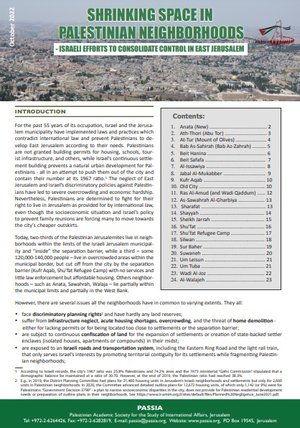Shrinking Space in Palestinian Neighborhoods- Israel Efforts to Consolidate Control in East Jerusalem
Overview
For the past 55 years of its occupation, Israel and the Jerusalem municipality have implemented laws and practices which contradict international law and prevent Palestinians to develop East Jerusalem according to their needs. Palestinians are not granted building permits for housing, schools, tourist infrastructure, and others, while Israel’s continuous settlement building prevents a natural urban development for Palestinians - all in an attempt to push them out of the city and contain their number at its 1967 ratio. The neglect of East Jerusalem and Israel’s discriminatory policies against Palestinians have led to severe overcrowding and economic hardship.
Nevertheless, Palestinians are determined to fight for their right to live in Jerusalem as provided for by international law, even though the socioeconomic situation and Israel’s policy to prevent family reunions are forcing many to move towards the city’s cheaper outskirts.
Today, two-thirds of the Palestinian Jerusalemites live in neighborhoods within the limits of the Israeli Jerusalem municipality and “inside” the separation barrier, while a third – some 120,000-140,000 people – live in overcrowded areas within the municipal border, but cut off from the city by the separation barrier (Kufr Aqab, Shu’fat Refugee Camp) with no services and little law enforcement but affordable housing. Others neighborhoods – such as Anata, Sawahrah, Walaja – lie partially within the municipal limits and partially in the West Bank. However, there are several issues all the neighborhoods have in common to varying extents. They all:
• face discriminatory planning rights and have hardly any land reserves;
• suffer from infrastructure neglect, acute housing shortages, overcrowding, and the threat of home demolition - either for lacking permits or for being located too close to settlements or the separation barrier;
• are subject to continuous confiscation of land for the expansion of settlements or creation of state-backed settler enclaves (isolated houses, apartments or compounds) in their midst;
• are exposed to an Israeli roads and transportation system, including the Eastern Ring Road and the light rail train, that only serves Israel’s interests by promoting territorial contiguity for its settlements while fragmenting Palestinian neighborhoods;
• face discriminatory land ownership laws which have been used to transfer land to settler groups, which then begin procedures to evict the Palestinian residents and take over their properties;
• and are threatened by Israel’s “settlement of title procedures” as part of the Government Decision No. 3790, which Palestinians and other critics see as an attempt to register land for future settlement expansion and further dispossess them.
In order to consolidate its control and prevent a political solution for Jerusalem, Israel pursues a policy of Judaization in two circles around the Old City, one in its immediate vicinity, consisting of “tourist” sites and national parks, and one forming a wider ring of settlements around the city (Ramot, Ramat Eshkol, Ramat Shlomo, Neve Ya’akov, Pisgat Ze’ev, the French Hill, Har Homa, East Talpiot, Gilo).
This bulletin provides an overview of the various Palestinian neighborhoods that make up East Jerusalem, describes their current situation, including available statistics, and shows how Israeli policies affect them due to settlement (expansion/enclaves) and other activities and plans.

